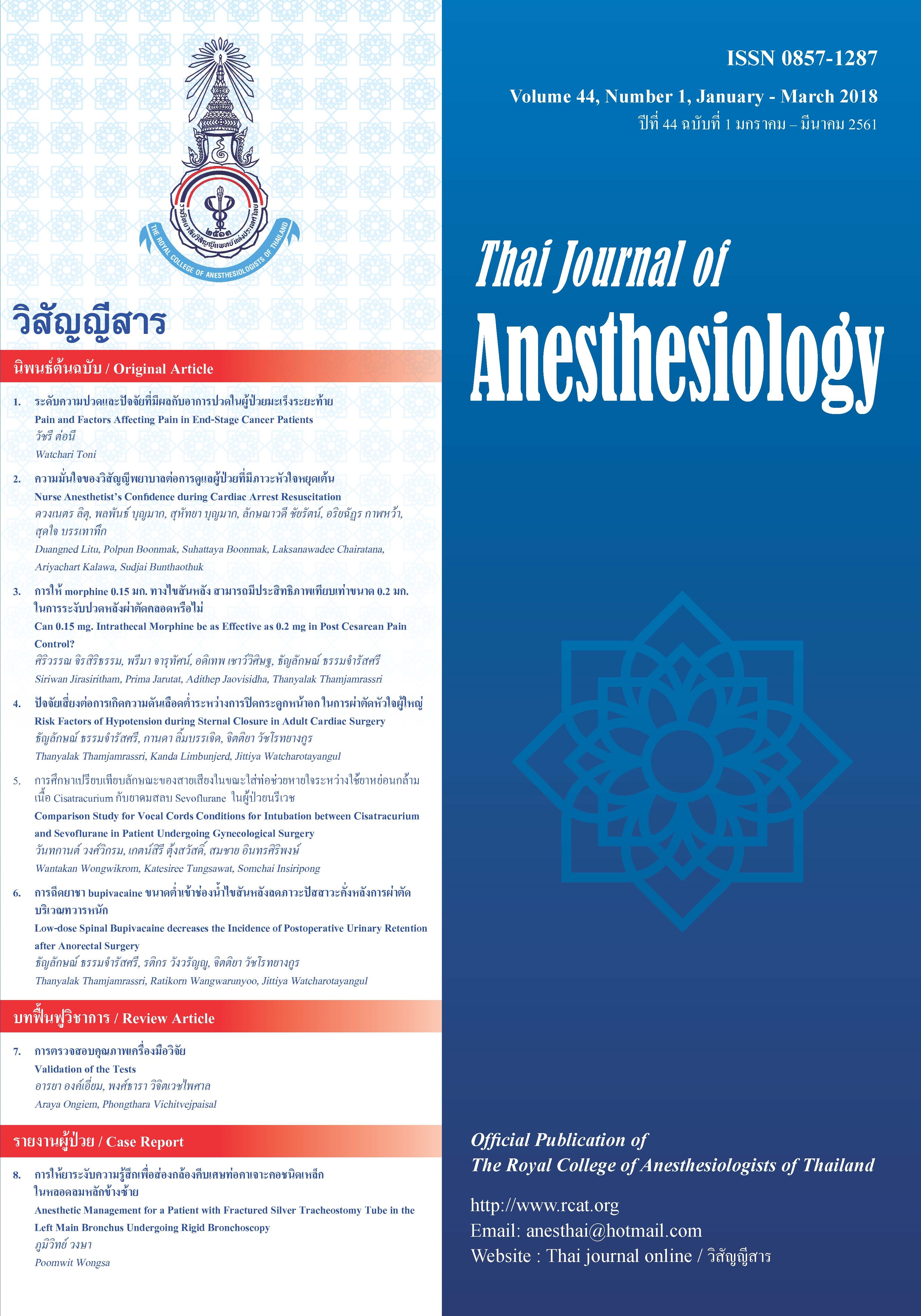Comparison Study for Vocal Cords Conditions for Intubation between Cisatracurium and Sevoflurane in Patient Undergoing Gynecological Surgery
Main Article Content
Abstract
Background: Intravenous induction (IV) followed by tracheal intubation using Neuromuscular blocking agent (NMB) during general anesthesia is a common practice in modern anesthesia. Avoidance of NMB is concerned in anticipated difficult airway or difficult IV access. Sevoflurane is an agent of choice for inhalation induction. Its gradual deepening of anesthesia and return of muscle tone when lightening.
Objective: To exam the conditions of vocal cords for endotracheal intubation by sevoflurane without the NMB agent compared to those by cisatracurium.
Methods: This prospective double blind control study. Randomly allocated 124 patients and divided into 2 groups; Group M (cisatracurium) and Group V (sevoflurane). In both groups premedication with Fentanyl and Midazolam then preoxygenated by 3 minutes. Anesthesia was induced with 8% sevoflurane N2O 4 LPM, O2 2 LPM. Spontaneous breathing until loss of eye rash reflex. Group M; the sevoflurane was closed then a bolus dose of cisatracurium 0.15 mg/kg IV and control ventilation 3 minute. Group V; controlled ventilation was continuously extended from the induction phase for 3 minutes and then each patient from each group was endotracheal intubated similarly by a nurse anesthetist.
Result: In the non-inferior analysis, Comparing vocal cord conditions Group V with Group M, opened and standing was 90.32% VS 83.87% (95%CI, P<0.03) . Incidence of hypotension before intubation (Proportion test) was 66.13% in group V and 50% in group M (95%CI, P=0.07)
Conclusion: Sevoflurane offers a smooth technique for induction and intubation non-inferiorly to intubation with neuromuscular blocking agent.
Article Details
References
2.
Barash PG, Cullen BF, Stoelting RK, Editors. Clinical anesthesia. 7th edition. Philadelphia: Lippncott; 2013, p137-41, 185-207.
3.
Yurino M, Kimura H. A comparison of vital capacity breath and tidal breathing techniques for induction of anaesthesia with high sevoflurane concentrations in nitrous oxide and oxygen. Anaesthesia 1995; 50: 308-11.
4.
Muzi M, Colinco MD, Robinson BJ, Ebert TJ. Effects of premedication on inhaled induction of anesthesia with sevoflurane. Anesth Analg 1997;85:1143-8.
5.
Yurino M, Kimura H. Induction of anesthesia with sevoflurane, nitrous oxide, and oxygen: a comparison of spontaneous ventilation and vital capacity rapid inhalation induction (VCRII) techniques. Anesth Analg 1993;76:598-601.
6.
C. E. Baker, I. Smith. Sevoflurane: a comparison between vital capacity and tidal breathing techniques for the induction of anaesthesia and laryngeal mask airway placement. Anaesthesia, 1999, 54, pages 841-844
7.
Muzi M, Robinson BJ, Ebert TJ, O’Brien TJ. Induction of anesthesia and tracheal intubation with sevoflurane in adults. Anesthesiology 1996;85:536-43.
8.
Glueck DH. Sample Size Calculations in Clinical Research 2nd edition by CHOW, S.-C., SHAO, J., and WANG, H. Biometrics. 2008;64(4):1307-8.


